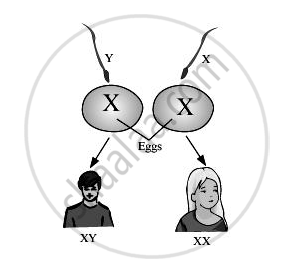Advertisements
Advertisements
प्रश्न
Gender of child is determined by the male partner of couple. Explain with reasons whether this statement is true or false.
उत्तर
Human females have two X chromosomes (XX) and human males have one X and one Y chromosome (XY). Therefore, the eggs produced by females have only X chromosomes while the sperms produced by males can have either X or Y chromosome. If an unfertilised egg fuses with a sperm containing X chromosome, then it gives rise to a girl child having two X chromosomes. If an unfertilised egg fuses with a sperm containing Y chromosome, then it gives rise to a male child having one X and one Y chromosome.

APPEARS IN
संबंधित प्रश्न
Draw a sectional view of human female reproductive system and label the part where
(i) eggs develop.
(ii) fertilisation takes place.
(iii) fertilised egg gets implanted.
Explain how the embryo gets nourishment inside the mother’s body.
What is the main difference between sperms and eggs of humans? Write the importance of this difference.
If a woman is using a copper-T, will it help in protecting her from sexually transmitted diseases?
Newly formed DNA copies may not be identical at times. Give one reason.
List the two types of reproduction. Which one of the two is responsible for bringing in more variations in its progeny and how?
State the main function of the Corpus luteum
Given below are diagrams showing the different stages in the process of fertilisation of an egg. in the human female reproductive tract.
Study the diagrams and answer the questions:
1) Arrange the letters given below each diagram in a logical sequence to show the correct order in the process of fertilisation.
2) Where does fertilisation normally take place? and What is ‘Implantation’ that follows fertilisation?
3) Mention the chromosome number of the egg and zygote in humans.
4) Explain the term ‘Gestation’. How long does Gestation last in humans?
5) Draw a neat, labelled diagram of a mature human sperm.
Give biological explanations for All the food chains begin with green plants.
State whether human beings reproduce by sexual method or asexual method.
Which part of the human body passes sperms from a man to a woman?
Mention two functions of human ovaries.
fertilisation in humans can occur only once in a month. Why?
What is the scientific name of birth canal?
Why is it an advantage for the testes to be situated in the scrotal sac outside the main body cavity? Can you think of one disadvantage?
What changes are seen in boys at the time of puberty?
Draw a labelled diagram of the human male reproductive system. With the help of this diagram, describe the working of human male reproductive system?
Explain why, fertilisation is possible if mating takes place during the middle of menstrual cycle.
Fertilisation results immediately in the formation of :
(a) a zygote
(b) an embryo
(c) a placenta
(d) a foetus
The normal gestation period in humans is:
Write two examples of sexually transmitted diseases caused by virus.
Describe in brief the role of testis in human male reproductive system.
Fill in the blank.
In humans, sperm production occurs in the organ ----------------.
In male and female reproductive system of human, ______ gland is same.
State whether the following statement is true or false:
Oviducts and fallopian tubes are one and the same thing.
Choose the correct answer:
The aim of sexual reproduction _________
Choose the correct answer:
Binary fission is a method of __________
Choose the correct answer:
Fertilization occurs in _____________
Choose the correct answer:
When pregnancy does not occur, the life of corpus luteum is about _____________
Draw a diagram to display the vertical view of human female reproductive system and label the following parts in the diagram:
(1) Ureter
(2) Ovary
(3) Funnel of fallopian tube
(4) Urethra.
Give the function of the following:
Uterus
Define the following:
Parthenogenesis
Define the following:
Sexual reproduction
Choose the Odd One Out:
Choose the Odd One Out:
Choose the Odd One Out:
The male homologue of the female clitoris is ____________.
Correct sequence in development is ______.
Which one of the following statements about human sperm is correct?
